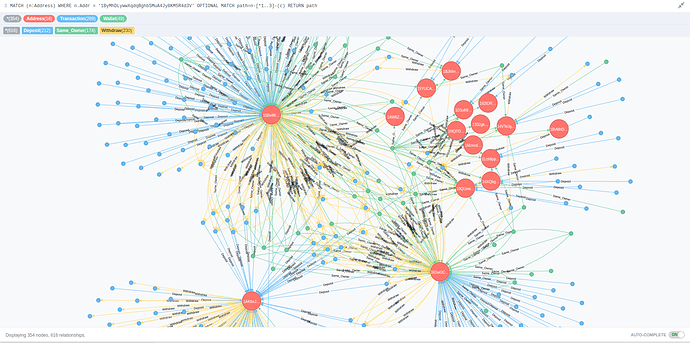The voting behavior of many addresses is similar to that of other addesses. I have made some correlation analysis. Between block 840,000 (20 Apr 2016 05:26:00) and 960,000 ( 11 Jul 2016 02:10:06) there are 120,000 blocks, minted by 421 addresses, 379 of which voted for at least one of 94 motion/grants (called m/g hereafter).
Correlation
Every address has a pattern in the 2-dimensional block-m/g space. A correlation score is calculated using the following method:
- when A finds a block at hight N, if B also finds a block within N +/- 200 block hight distace from the block of A (called the sample range), then a 2-block score is calculated as the ratio of the number of m/gs that both A and B voted yes, divided by the total m/gs they vote, in these pair of blocks. So the score is 1 if they vote identically. Agreement of no vote doesn’t count.
- If B finds more than one blocks in the sample range, an average score is taken. A vriance is calculated. This score is the block score of B for A at N.
- Then all block scores of B is averaged for all blocks A has found to get a correlation score bteween A and B. The vriance is also averaged. (Weighted average was tried but not used). Total number of block scores for every “B” is also recorded for refernce.
Groups
All voting addresses are grouped based on their correlation with others. Starting with the address that has the highest balance (taken approximately when OP was posted), all addresses whose correlation with the address is >= 97% are regarded as of the same unrestricted group. The process repeats until there are less than 20 addresses not in any unrestricted group. These addresses have small balances and don’t find many blocks (reliable scores ), and are put into a loner group.
An address can show up in multiple unrestricted groups, which is understandable. To investigate vote distribution, each addresses is allows to only belong to the group where it has the highest score. If the scores of an address are the same in multiple groups, the highest “Total number of block scores” is used. If a group turns out to have one member, its member are put into the loner group. Eventually there are less than 40 such unique groups.
Group voting
In the following charts, every row shows the number of shares every group contributed to voting in the 5000 blocks starting at the height marked on the left. Every cell is marked with the number (unit is million NSR). The shade of red and size of blue bar is proportional to the number. For example cell D:840000 has 54.8. It means this group had 54.8 m NSR voted for some motion from block 840000 to 845000 (about a half week’s time). The whole column is 49-54 m NSR meaning that this group has been constantly voting (compare it with group G, which voted on and off).
Using multi-motion pattern information, I can associate some groups with datafeed provider, or at least have some comments on its main characters:
B 67 biggest group by membership. unidentfied. constantly voting.
C 44 *first to vote for Phoenix’s motions
D 29 cryptog datafeed.
E 24 cybnate datafeed 18/24
F 22 *only vote for pheonix
G 15 *phoenix
H 15 the loner group
I 14 cybnate datafeed 7/14
J 14 *phoenix?
K 13 cybnate datafeed 11/13
M 11 cybnate datafeed 6/11
N 10 old cryptog feed?
O 9 cybnate datafeed 3/9
P 8 cybnate datafeed3/8
Q 7 *only vote for pheonix
R 6 “sixpack” phoenix fan
AA cybnate data feed3/3
The left column shows block height. Earlier blocks are at higher places. The folloing is a rough timeline of block numbers and “voting started” “pass” of some of the motions
20 Apr 2016 05:26:00 840000
8 May 2016 01:06:53 865000
22 May 2016 886496, start voting "1%"
25 May 3:27am ~889500 start "mOD"
7 Jun 4:39pm 908031 start "firing"
9 Jun 1:02am 910200 withdraw "firing"
15 jun 18:20 920690 start "commander"
19 jun 12:50pm 92500 pass "mOD"
22 Jun 2016 20:22:55 930000
23 Jun 2016 21:58:54 931878 "1%" reaches 80% support in 100 conseq. blocks.
24 jun 3:09am 931554 start "elect"
24 jun 3:37am start "20m nsr grant"
25 Jun 2016 16:22:17 935000
28 Jun pass "1%"
28 Jun 2016 17:33:13 940000
28 jun 9:52 start "report"
4 Jul 2016 03:48:42 950000
4 jul 6:15 "20m nsr grant" passed
4 jul 4:44pm pass "elecct"
11 Jul 2016 02:10:06 960000
where the “mOD” and “1%” etc. motion/grants symbols are
- bd4d153bb5c2d8cd6013b77ad8780eabc7bae79e @masterOfDisaster 's 1% Maximum Spread for ALP/MLP, Above 1% Allowed for Nu Funded Liquidity Operations (e.g. Gateways) b71a585de0b5e552648036fbc8282e11fea4a1cc 1% Maximum Spread in Shareholder Funded Liquidity Operations
- c070f654c2ff3e43a10fc5ff1dbf8ad74e36b18f Make Firing and Replacing Incompetent Liquidity Providers Our Top Priority
- SWm1xC4n5jSGjRRdSKfzroUBgTto2zRA8X Elect Phoenix Commander of Liquidity Operations
- 70aa7e974a4a82b866c0835ba62be43f65c96409
- SUrJhmYVeNThoG6oFWjY9pMawRJ3iCTHCq Grant NSR to Phoenix for liquidity operations
- 89fc44bd7ebe3c3c4c9c017f5483d82122b64b7f
- ShrB92Q61TiL9ZaQXZQCMB2qszYKqTMkGU Elect Phoenix as Chief of Liquidity Operations (compromise version)
- 5219085f8d307426f9f45ee9b2c3e80fd37052ca
- c0ee465965ce8fe1fe03b169024ac049211e4a76
- f8b9e060dc73a97fd28a62ecfdd419114892787a Temporarily cap NBT supply with full reserve
- 57ee6c5da13b0c91ca05a4f32e1a7bf9b44811b4 Create Chief of Liquidity Operations Position
- 1118f2334d0ef45676b38ebe2daaf30a8a345a7f 100% Reserve Required for NuBits
- 470ba7bf40099c395b8fb569367d16ce6167c2bd
- faafd2dea7c11fc27155118469140c0b0dd66eb3 A Report on Peg Abandonment and How to Proceed From Here
- SRKudQwjKPAgcvAoqUpYJ5KwBBqbJYrPn5 2nd NSR Grant for Liquidity Operations
- 0a07006225dde507319ea0beb50b6a509a9ae380
The total network minting power is 414 m NSR at 955000. It can be seen that groups B-E,H,L-N,S,T are constantly voting, providing 153 m NSR. The broken column shows the group coming into and out of voting.

